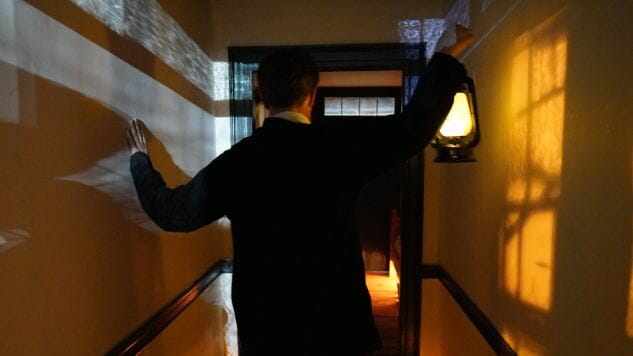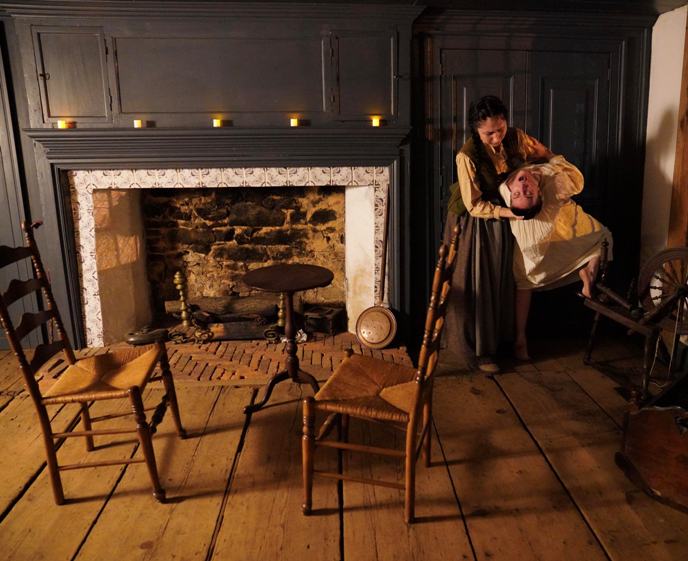The Visitation Reveals the Game In All Art
Photos by Carly Hoogendyk, courtesy of The Visitation Games Features The Visitation
Are games art? It’s a familiar question (honestly, a thoroughly exhausted question) that’s generally proposed in connection to lengthy, redundant debates as to whether games (videogames specifically) should be given the same legal protection as other means of creative expression. At this point, I think it’s a foregone conclusion that this take is reductive and off-base. But whatever. A more appropriate question today would be: how does interactivity define a work of art?
There are many ways of tackling this, from taking a one-word suggestion at an improv show to the terrifying collapse-of-society’s-thin-veneer monkey antics of this year’s The Square. But it’s a question that essentially rounds out the cast of The Visitation, the new immersive theatrical experience currently running at the Wyckoff House in Brooklyn—New York’s oldest building and a place where I would literally live in the 1600s full-time before I’d spend a single night there alone.
The conceit of The Visitation is simple; the execution anything but. As the audience gathers in a central room of the preserved Dutch house, two priests enter and are debriefed on the situation. This family believes their daughter is possessed by the Devil. The priests promise to help as best they can after they decompress from their journey. As soon as they split in different directions, it’s up to you who to follow. The Reverend George Wake (Daniel Harray), a man said to have communicated directly with God? The Reverend Francis Prideaux (Brian L. Evans), a new priest eager to be on the case? You could follow either Brian Gunter (Ben Gougeon), the gruff father of the house, or Marion Gunter (Virginia Logan), its reserved mother. You could enter the room of Anne Gunter (Rae Haas), the afflicted, or you could follow the taciturn servant Patience Massingberd (Yurie Collins). You can switch between any of the intersecting storylines at any time, or you could just wait in an empty room until the story comes to you. But there is absolutely no way to watch all of The Visitation. Not at once. If you went back enough times to catch every individual scene, you’d still have seen dozens of different shows.

To say much more would be to spoil the terrifying Nathaniel Hawthorne-meets-The Exorcist tale. Or, at least, the story as far as I know—many times I’d follow a priest into the grounds only to hear a scream from indoors, and would stand in the doorway torn between the two. (My mother used to see school plays at least twice to see what she missed the first time around. She’d be back for every performance of this show.)
As we’re told before The Visitation begins, we are here to bear witness. We cannot speak, we cannot touch. We cannot interfere in any way. And yet the show is more interactive than most straight games. Because while you have no way to effect the narrative as far as the characters are concerned, every choice you make has a profound impact on the narrative you experience and how you experience it. The thrill of that experience comes when you realize the extent of your freedom as an observer—at which point you have to be increasingly deliberate about what you choose to follow. You are going to miss a lot, but The Visitation has put the onus on you to choose what you’ll miss based on the information you have.
In this way, The Visitation is an extreme example of the interactive truth that defines how we process all art. Going back to follow Brian Gunter or prioritize the disturbing twists and turns of Anne’s possession isn’t so different from re-listening to a song for the bass line, which itself isn’t so different from going back and playing through a videogame as an elf instead of a dwarf.
If you go see The Visitation, which you should, I’d encourage you to, obviously, heed the instructions not to speak or touch anything (the tension in the house was such that when I whispered “sorry” after bumping into another patron, I privately thought the house was going to explode from my violation of that sacred pact). But I’d also suggest that you not think of yourself as a mere observer.
All art is preprogrammed for us. Even in improv—or any other art that is invented on the spot—and even in the most interactive game possible, our only measure of control over it is how we choose to experience it. The Visitation can be read, then, not as evidence that all games are art, but that every work of art is a game.
The Visitation runs through March 25th.
Graham Techler is a New York-based writer and comedian. You’d be doing him a real solid by following him on Twitter @grahamtechler or on Instagram @obvious_new_yorker. A real solid.